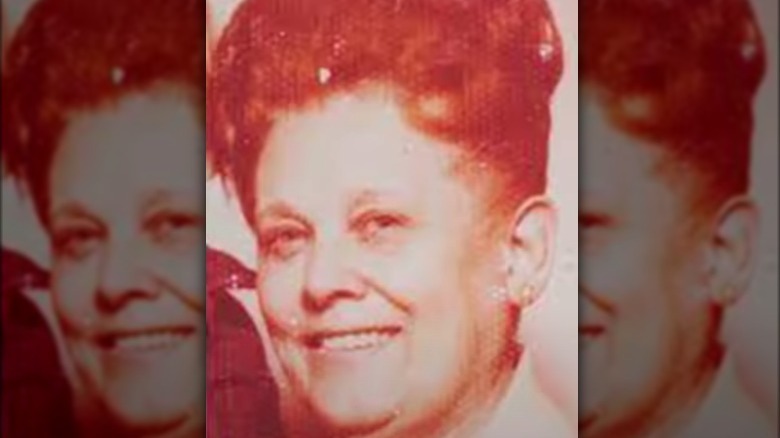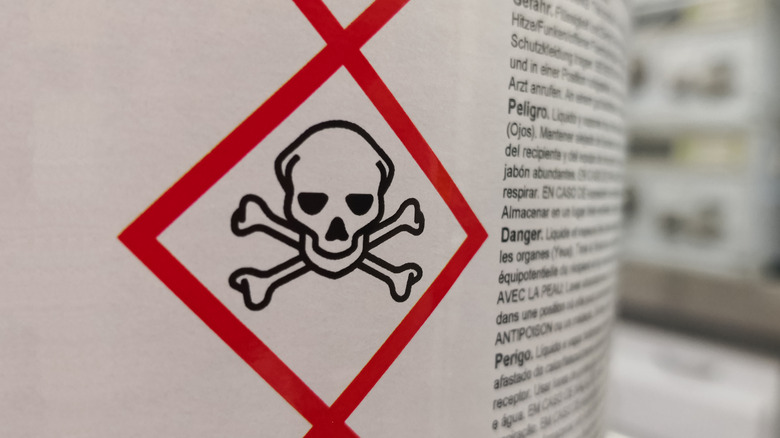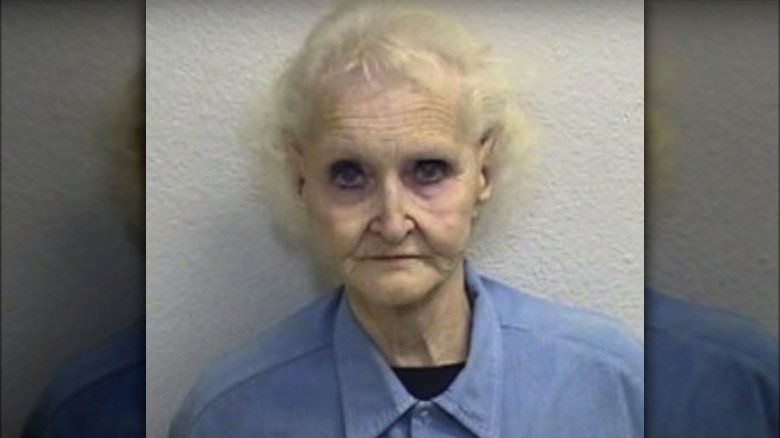What Happened To Dorothea Puente's Victim Ruth Monroe?
On the outside, Dorothea Puente looked like an average grandmother (via the New York Post). She had white hair, oversized glasses, and a pleasant demeanor. As it turns out, Puente was the definition of evil. According to All That's Interesting, it's believed she killed up to nine people in her Sacramento home between 1982 and 1988. Puente targeted individuals who were on the fringes of society — those with mental illnesses, addictions, the elderly. Puente would poison or strangle them to cash in their social security checks. Sactown Magazine writes that this would earn Puente $5,000 a month.
As she involved herself with charity work and the local community, no one suspected a thing. Oxygen writes that Puente's early life was marred with tragedy and perhaps contributed to making her a serial killer. She was orphaned as a child and allegedly sexually abused. Puente turned to sex work and eventually got married four times, per Bustle. She subsequently ran into legal trouble for sex work and writing a check under a false name. This didn't stop Puente from opening up her first boarding house to the needy and disabled in the 1970s. She was eventually shut down and arrested after being caught stealing from her helpless tenets.
Dorothea Puente's horror-filled boarding house
Before her arrest, Oxygen writes that her friend, Ruth Monroe (above), had died at Puente's home under mysterious circumstances. However, the death was ruled a suicide and police moved on (per All That's Interesting). Puente spent three years in prison for the thefts. By 1985, she was free and on her way to opening her second boarding house (via Bustle). Located at 1426 F Street in Sacramento, California, Puente's modus operandi for her new boarding home was the same as the first. Just as before, she housed people who were not in the best physical or mental condition.
In addition, most of her tenants had no friends and family. When they began to disappear, no one batted an eye. Puente was an expert atin coming up with excuses, and anyone who questioned her bought them. Per The Cinemaholic, eventually, Dorothy Miller, Benjamin Fink, Leona Carpenter, and Bert Montoya all went missing while living in Puente's home. However, it would be Bert Montoya's disappearance that would lead to the end of Puente's house of horrors. Unlike the other boarders, Montoya had someone who was looking out for him: Judy Moise (per the New York Post).
This was how Dorothea Puente was caught
According to The Cinemaholic, Montoya suffered from schizophrenia and went missing in 1988. The New York Post writes that Moise was his social worker and noticed something was amiss when she was unable to get hold of him. Puente insisted that he had gone to visit his family in Mexico but Moise knew this was a blatant lie. Eventually, the authorities got involved and went to Puente's home (via Oxygen). They searched the residence and found nothing. Moreover, the other tenants corroborated Puente's story.
Before they left, one of them slipped a note to the police that stated that Puente had asked him to lie. Later, Bustle reports that he also told them to check the backyard. At Moise's instance, Screen Rant explains that they did exactly that and began to dig. In Puente's backyard, authorities unearthed the remains of her seven missing tenants, including Montoya. Before she could be arrested, Puente fled to Los Angeles (per All That's Interesting). She was quickly caught when a man at a bar called the authorities after he recognized her from TV.
Ruth Monroe was her first victim
Screen Rant reports that Puente was returned to Sacramento and was subsequently charged with nine murders, including that of Ruth Monroe. According to Oxygen, it's widely believed that Monroe was her first victim. As All That's Interesting explains, Monroe's death was ruled a suicide by police. However, the Los Angeles Times notes that at the time of Monroe's death, the coroner was unsure if the death was a suicide or a murder. In 1982, Monroe was 61 years old when she moved in with Puente. Monroe was reportedly reeling from her husband's recent terminal cancer diagnosis, per Sactown Magazine.
In an effort to save money, Monroe moved into Puente's first boarding home (via The Cinemaholic). Three weeks later, Monroe was dead. She was found in her room; an autopsy determined that she had overdosed on codeine and acetaminophen. Although her family disagreed with this assertion, Puente explained to police that Monroe had not been the same since her husband's diagnoses. They did not question her any further and Monroe's death was considered a suicide until Puente's murder trial.
Ruth Monroe was Dorothea Puente's business partner
As explained by Sactown Magazine, Puente and Monroe had history. Screen Rant writes that Monroe considered Puente her best friend, to the point where Puente insisted she be called Grandma by Monroe's children (via the New York Post). In 1981, the duo decided to open a restaurant together. Not long after that, Monroe's husband received the news that he had terminal cancer. When Monroe moved in with Puente, her family notes that Monroe quickly went down hill. She complained of feeling ill and began drinking alcohol. Her son William Clausen later said, "That didn't seem right, but Dorothea had conned our whole family into thinking she was a nurse."
Days later, Monroe died, leaving her family shocked and confused, and even more so when police ruled her death a suicide (via All That's Interesting). They also found that Puente had taken all of Monroe's money. The Cinemaholic writes that soon after, Puente was arrested for drugging and robbing elderly people for their pensions. With this news, Monroe's family insisted to authorities that she had been poisoned by Puente and was another one of her victims. The police refused to look into it until the seven bodies were found in her yard a few years later. Clausen expressed regret and said that if Puente had been held responsible for his mother's murder, she perhaps would not have been able to kill her other tenants.
Dorothea Puente was not convicted of Ruth Monroe's murder
Per Oxygen, Puente (above) maintained her innocence of all the murders at her 1993 trial. She claimed that each and every one of her tenants had died due to natural causes (via The Cinemaholic). All That's Interesting writes that the prosecution believed otherwise. They stated that she had drugged and suffocated her victims before burying them in her backyard. They cited the drug Dalmane, which was found in the remains of the seven victims, as the proof. Dalmane is used to treat insomnia, something Puente reportedly struggled with and had several prescriptions for. Despite the bodies and Puente's previous legal issues, the trial was a difficult one.
The New York Post writes that pathologists were unable to pinpoint the cause of death for any of the victims. In addition, the jury became deadlocked. However, Puente was eventually found guilty of three murders, including those of Dorothy Miller, Benjamin Fink, and Leona Carpenter. Screen Rant writes that they did not convict her of Ruth Monroe's murder. The Los Angeles Times notes that the jury was unable to come to a consensus in terms of Monroe's death. Puente received a life sentence and died in prison at the age of 82 on March 27, 2011.
The story of Puente and her victims, including Ruth Monroe, is part of the Netflix docu-series "Worst Roommate Ever." The trailer is on YouTube.





